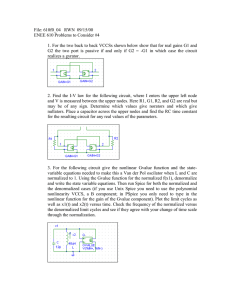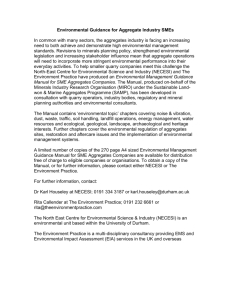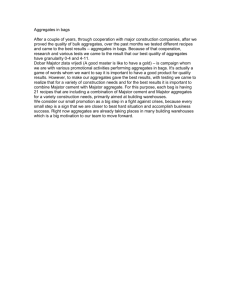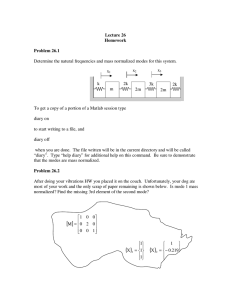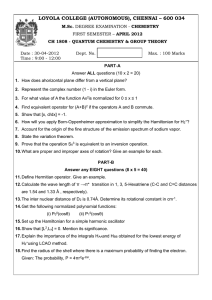The Organization of Microphysical Processes in Mesoscale Convective Ocean
advertisement
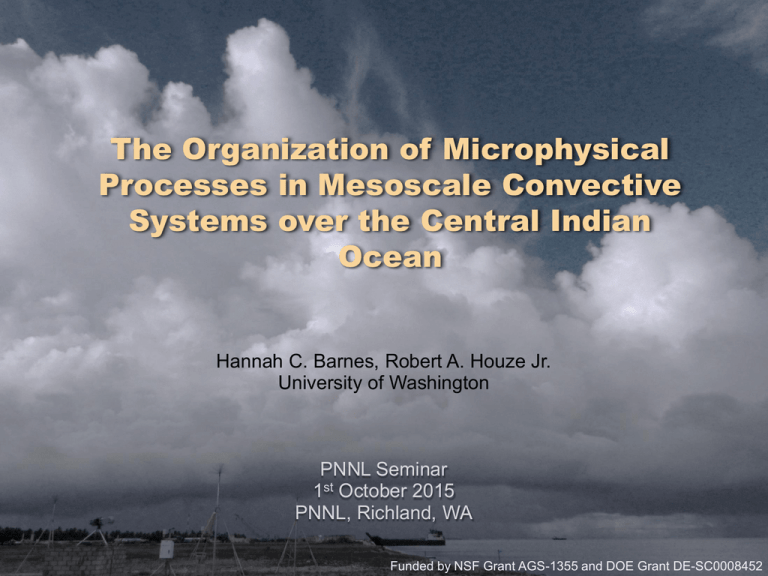
The Organization of Microphysical Processes in Mesoscale Convective Systems over the Central Indian Ocean Hannah C. Barnes, Robert A. Houze Jr. University of Washington PNNL Seminar 1st October 2015 PNNL, Richland, WA Funded by NSF Grant AGS-1355 and DOE Grant DE-SC0008452 Mesoscale Convective Systems (MCSs) • Contiguous precipitation over 100 km • ~ 60% of tropical precipitation Stratiform Region Convective Region Y X Houze 1997, 1989, 2004 MCSs: Latent Heating • Convective, stratiform distinctly different • • MCSs important source Influences storm dynamics and large-scale circulation Mesoscale Contribution to MJO Latent Heating based on TRMM PR Idealized Profiles Shallow Deep Convective Storms Wide Convective Storms Broad Stratiform Storms Weaker Storms All Storms 14 12 12 10 8 6 Height (km) Height (km) 10 Stratiform 4 2 -2 0 2 Latent Heating 4 (Kday-1) 6 4 2 Convective 0 -4 8 6 Active MJO Phase 0 0 0.02 0.04 0.06 0.08 Net Latent Heating (Khr-1) Schumacher et al., 2004; Barnes et al., 2015 MCSs: Latent Heating and Microphysical Structure • Microphysical processes associated with latent heat • Theorized but direct observations and validation limited Houze, 1989 Microphysical Structure of MCSs Observation and validation difficult Observation / Validation Method Advantages Disadvantages Aircraft Observations • In situ • Spatially limited • Temporally limited Particle ID (PID) from dualpolarimetric radar Numerical Simulations • Complete spatial coverage • Complete temporal coverage • All processes Difficult to validate • Difficult to validate • Theory & observation based • Theory based • Limited by radar quality • Parameterizations • Dominant only • Different schemes • Large spatial coverage • Increased temporal coverage • Objective: Is microphysical structure from PID and WRF consistent with each other and dynamics? MCSs: Kinematic Structure • Layered airflow • Three-dimensional Convective Stratiform Kingsmill and Houze, 1999a Outline Spatial organization of hydrometeors / ice processes around midlevel inflow • Part 1: Radial Velocity and Dual - Polarimetric Radar Analysis – Systematic hydrometeor organization around midlevel inflow – Frozen hydrometeors ~ Ice microphysical processes • Part 2: WRF Simulations – Force squall by assimilating radial velocity • Part 3: Intercomparison – Broad structure similar – Details differ Part 1: Radial Velocity and Dual – Polarimetric Radar Analysis NCAR S - PolKa Radar • • DYNAMO / AMIE (Oct 2011 – Jan 2012) Addu Atoll, Maldives • • • S - Band Single Doppler Dual - polarimetric Dual - Polarimetric Radar Reflectivity Reflectivity dBZ 15 40 • 0150 UTC 18 November 2011 Emit and receive vertical and horizontal pulses Variables – Differential Reflectivity (ZDR) • Shape, phase – Specific Differential Phase (KDP) • Water content – Correlation Coefficient (ρHV) • Phase, diversity – Linear Depolarization Ratio (LDR) • Phase, orientation, diversity 20 5 0 0 0 20 40 60 Correlation Coefficient Differential Reflectivity Height (km) • 10 15 dB 1.5 15 10 1 10 1 0.98 0.5 5 5 0 0 0 20 40 0 Specific Differential Phase 15 0 0 60 20 40 60 Linear Depolarization Ratio °km-1 1 15 0.5 10 dB -18 -20 10 0 5 -0.5 0 0 20 40 60 -22 -24 5 -26 -28 0 0 20 Distance from S-PolKa (km) 40 60 NCAR Particle Identification Algorithm (PID) Categories Algorithm • • Mimics radar expert Identifies most likely dominant hydrometeor Based on theory, observations, experience • Particle ID Rain • • • Heavy Rain Moderate Rain Light Rain Mixed Phase 15 • • Graupel/Rimed Aggregates Wet Aggregates Height (km) 10 Frozen 5 0 0 20 40 60 Distance from S-PolKa (km) • • • Dry Aggregates Small Ice Crystals Horizontally-Oriented Ice 0150 UTC 18 November 2011 Vivekananda et al., 1999 Compositing Methodology Methodology: Case Selection • Subjectively identify RHIs • Radial velocity • Midlevel inflow • One per storm • 37 midlevel inflows analyzed Reflectivity PPI Radial Velocity RHI 50 Height (km) Distance from S-PolKa (km) 100 0 -50 -100 -100 -50 0 100 50 Distance from S-PolKa (km) 16 20 14 15 12 10 10 5 8 0 6 -5 4 -10 2 -15 0 0 20 40 60 80 100 Distance from S-PolKa (km) 1900 UTC 23 December 2011 -20 Methodology: Compositing 1.) Map kinematics and hydrometeors using radial velocity and PID 2.) Composite around layer lifting model 1900 UTC 23 Dec 2011 Particle ID Radial Velocity Generic Midlevel Inflow m/s 20 16 SIC HIC 15 14 WA 12 10 Height (km) DA 10 5 G/R G/RA 0 8 H 6 -5 H/R 4 -10 HR MR -15 2 0 0 LR -20 20 40 60 Distance from S-Polka (km) 80 100 Z Scale Factor X Scale Factor Methodology: Composite Results Normalized Height Wet Aggregates 4 0.8 3 0.7 0.6 2 0.5 1 0.4 0 0.3 0.2 -1 -2 -0.25 0.1 0 0.25 0.5 0.75 Normalized Range 1 1.25 Midlevel Inflow Composites Moderate Rain Normalized Height Heavy Rain 4 4 4 4 3 3 3 3 2 2 2 1 1 1 0 0 0 0 -1 -1 -1 -1 -2 0 0.25 0.5 0.75 1 -2 0 0.25 0.5 0.75 2 1 -2 1 0 Normalized Range Wet Aggregates 4 Graupel / Rimed Aggregates Light Rain Dry Aggregates 0.25 0.5 0.75 -2 1 Small Ice Crystals 4 4 3 3 3 3 2 2 2 2 1 1 1 1 0 0 0 -1 -1 -1 0 0.25 0.5 0.75 1 -2 0 0.25 0.5 0.75 1 -2 0.25 0.5 0.75 1 Horz. Oriented Ice 4 -2 0 0 -1 0 0.25 0.5 0.75 1 -2 0 0.25 0.5 0.75 1 Graupel in Stratiform 0150 UTC, 18 November 2011 15 50 Reflectivity 40 Height (km) Height (km) Graupel/Rimed Agg. Wet Aggregates Particle ID 15 10 5 30 10 20 5 10 0 0 0 2 4 0 0 6 15 Height (km) Height (km) Radial Velocity 10 5 0 0 2 4 6 Distance from S-PolKa (km) 4 6 Distance from S-PolKa (km) Distance from S-PolKa (km) 15 2 Differential Reflectivity 1 10 0.5 5 0 0 1.5 2 4 6 Distance from S-PolKa (km) 0 Graupel in Stratiform 0150 UTC, 18 November 2011 Graupel / Rimed Aggregates Wet Aggregates Only Height (km) Reflectivity Profile (dBZ) Height (km) Differential Reflectivity Profile (dB) Graupel in Stratiform Theoretical Support Videosonde Observations 9 January 2005: Central Indian Ocean Thick stratiform, gentle rain, bright band Graupel 5.2 km 0.7°C Aggregate 4.8 km 1.1°C 5 mm Leary and Houze, 1979 Suzuki et al., 2006 Aggregate 4.9 km 0.2°C Radar Analysis Conclusions Conceptual Model of Hydrometeor Type within Midlevel Inflow Small Ice Crystals Horz.-Oriented Ice -20˚C Dry Aggregates Graupel / Rimed Aggregates Z 0˚C Wet Aggregates Light Rain Are ice processes layered in WRF? X Moderate Rain • Heavy Rain Frozen hydrometeor categories indicate microphysical process • Small Ice Crystals & Horz. Oriented Ice = Deposition • Dry Aggregates = Aggregation • Graupel / Rimed Aggregates = Riming • Wet Aggregates = Melting Barnes and Houze, 2014 Part 2: WRF Simulations Must have midlevel inflow WRF Data Assimilation Penn State University EnKF / WRF Assimilation Time 23 Dec 2011 1200 - 2000 UTC Every 15 mins starting at 1800 UTC 9 Initialization Vertical Levels Domains Members Assimilate Planetary Boundary Layer Parameterization ERA - Interim S-PolKa and WRF Domains 6 39, Top at 26 km 3 km, 1 km 3 50 Domain 1 (3 km) Longitude Simulation Time S-PolKa 0 S - PolKa radial velocity Domain 2 (1 km) -3 Bretherton and Park (UW) Latitude -6 68 Longwave Radiation Parameterization RRTM Shortwave Radiation Parameterization Dudhia Surface Layer Parameterization MM5 Similarity Microphysics Parameterization • Milbrandt – Yau • Morrison • WDM6 • • 72 76 80 Group production terms by process • All processes • Provides rate (kg kg-1 s-1) Composite members containing midlevel inflow Compositing Methodology Midlevel Inflow Member Selection 16 14 12 m/s Shading: Horz. Horz. Speed Speed Shading: White Contours: Contours: Reflectivity Reflectivity White Black Contours: Contours: Horz. Horz. Speed Speed >> 18 18 m/s m/s Black Dots: Max Speed at level post tests 20 15 Height (kn) 10 8 10 6 4 5 2 0 73 73.5 Longitude 74 Milbrandt: Member 17 1930 UTC 23 Dec 2011 74.5 0 Midlevel Inflow Compositing 16 14 Original Height (km) 12 10 dBZ 50 Shading: Reflectivity Black Contours: Horz. Speed > 18 m/s Dots: Max speed at level post test Red Lines: Analysis boundaries 45 40 35 30 8 25 20 6 15 4 10 2 5 0 0 73 16 14 73.5 Longitude 74 74.5 dBZ 50 Shading: Reflectivity Black Contours: Horz. Speed > 18 m/s 45 40 Scaled Height (km) 12 35 10 30 8 25 20 6 15 4 10 2 5 0 0 73 73.5 Longitude 74 Milbrandt: Member 17 1930 UTC 23 Dec 2011 74.5 Squall Line 1930 UTC, 23 December 2011 Squall Line Structure S-PolKa Milbrandt - Yau Morrison Maximum Reflectivity Map 75 Distance from S-PolKa Distance from S-PolKa (km) 100 50 25 0 -25 -50 -75 -25 0 25 50 75 100 125 150 Distance from S-PolKa (km) Distance from S-PolKa (km) Wind Speed Cross Section (along red line above) 16 14 10 Height (km) Height (km) 12 8 6 4 2 0 0 25 50 75 100 125 150 Distance from S-PolKa (km) Normalized Zonal Distance WDM6 Part 3: Intercomparison WRF • All • Type, Location, Rate PID • Dominant only • Type, Location Compare location only Deposition S-PolKa PID Milbrandt - Yau Morrison WDM6 Small Ice Crystals = Deposition 0.5 3 -20°C 2 0.3 1 0°C 0 0°C 0.2 0.1 -1 -2 0.4 -20°C 0 0.25 0.5 0.75 1 Mean Production Rate (kg kg-1 s-1) Normalized Range 3.1e-6 3.7e-7 Adjusted Height Normalized Height 4 Adjusted Height Occurrence Frequency -20°C 4.4e-8 5.2e-9 0°C Normalized Zonal Distance Aggregation Frozen Collecting Frozen S-PolKa PID Milbrandt - Yau Morrison WDM6 Occurrence Frequency 3 0.9 -20°C 2 1 0.7 0.5 0°C 0 0.3 -1 0.1 -2 0 0.25 0.5 0.75 -20°C 0°C 1 Mean Production Rate (kg kg-1 s-1) Normalized Range 1.3e-5 4.2e-11 Adjusted Height Normalized Height 4 Adjusted Height Dry Aggregates = Aggregation -20°C 1.3e-16 4.3e-22 0°C Normalized Zonal Distance Riming Frozen Collecting Liquid S-PolKa PID Milbrandt - Yau Morrison WDM6 Graupel/Rimed Aggregates = Riming 3 -20°C 2 0.2 0.16 1 0°C 0.12 -20°C 0°C 0 0.08 -1 0.04 -2 0 0.25 0.5 0.75 1 Mean Production Rate (kg kg-1 s-1) Normalized Range 1e-4 Adjusted Height Normalized Height 4 Adjusted Height Occurrence Frequency 1.8e-7 -20°C 3.4e-10 6.3e-13 0°C Normalized Zonal Distance Melting S-PolKa PID Milbrandt - Yau Morrison WDM6 Occurrence Frequency 3 0.8 -20°C 2 1 0°C 0.6 0.4 0 -20°C 0°C 0.2 --1 -2 0 0.25 0.5 0.75 1 Mean Production Rate (kg kg-1 s-1) Normalized Range 9.6e-5 1.6e-6 Adjusted Height Normalized Height 4 Adjusted Height Wet Aggregates = Melting -20°C 2.8e-8 4.9e-10 0°C Normalized Zonal Distance Conclusions • Ice microphysical processes have layered structure – Broadly similar – Details differ • Aggregation and riming - WRF deeper • Deposition – WRF extends lower • Melting – Consistent except Milbrandt-Yau • • Large-scale similarities encouraging Research needed to resolve detail differences Small Ice Crystals Horz.-Oriented Ice Dry Aggregates Graupel / Rimed Aggregates Wet Aggregates -20˚C 0˚C Light Rain Z X Moderate Rain Heavy Rain Conceptual Model of Hydrometeor Type within Midlevel Inflow Back Up Slides Particle Identification Algorithm (PID) Polarimetric Data Z, ZDR, KDP, LDR, ρHV, Temp PID Algorithm Characterize how well categories represented by data • Fuzzy logic based • Interest value Hydrometeor Classification Max interest value Microphysical Process Definitions Ice Nucleation Definition Milbrandt Yau Morrison WDM6 Aggregation Frozen hydrometeors New frozen hydrometeors collecting other forming frozen hydrometeors QFZci, QNUvi, QFZrh mnuccd, mnuccr, mnuccc Pigen Riming Melting Frozen hydrometeors collecting liquid hydrometeors Frozen hydrometeors melting into liquid hydrometeors Deposition prai, prci Raindrop Condensation Evaporation Collection Liquid Frozen Liquid Frozen hydrometeors Liquid hydrometeors hydrometeors hydrometeors collecting hydrometeors losing mass losing mass liquid or collecting collecting water to water to water frozen water vapor vapor vapor vapor hydrometeors QCLis, QCLig, QCLcs, QCLsh, QCLcg, QVDvi, QVDvs, QMLir, QMLsr, QCNis, QCLch, QVDvh, QMLgr, QMLhr QCNsg, QCLrg, QCLrs, QVDvg QCNgh, QCLih QCLri, QCLrh psacws, pgracs, psacwi, psacwg, psmlt, pgmlt pgsacw, psacr, pracg, pracis, praci, piacrs Sublimation prd, prdg, prds Psacw, Pgacw, Psaci, Pgaci, Paacw, Piacr, Pidep, Psdep, Psaut, Pgacs, Psmlt, Pgmlt Psacr, Pgacr, Pgdep Pgaut Pracs QVDvi, QVDvs, QVDvh, QVDvg RCAUTR, RCACCR, QCLsr, QCLgr QREVP eprdg, eprds, pre, pcc, piacr, pra, prc eprd evpmg, evpms pre, pcc, evpmg, evpms Praut, Pracw, Pidep, Psdep, Praci, Pseml, Pgdep Pgeml Pcond Prevp, Psevp, Pgevp Radial Velocity Prep Radar Quality Control (NCAR) Super-Observations • Locations were PID present only • Bins: 2° x 1 km • PID used to remove • Quality control: < |45 ms-1| • • Insects • 2nd trip • Saturation • Rules: • • • Remove pixels with: • Low signal-to-noise ratio • Clutter • High spectral Width • Distance from S-PolKa (km) 150 100 100 50 50 0 0 -50 -50 -100 -100 -50 0 50 Remove all obs (obs – bin mean) > 2*std(bin) • Remove obs at fault Median value SuperObs Radial Velocity QCed Radial Velocity Raw Radial Velocity 150 -100 Remove all Obs std(bin) > std(all) • • -150 < 2 obs in each bin 100 150 -150 150 100 50 0 -50 -100 -100 -50 0 50 100 150 Distance from S-PolKa (km) -150 -100 -50 0 50 100 150 Ensemble Initialization • • Steps • Create ensemble of control vectors with mean = 0 and standard deviation = 1 • Perturb each control vector using BE (U,V, θ, qv) • Update boundary conditions so consistent with perturbations Background error covariance (BE) • BE = describes random errors in background field • Generated from cv5 option in WRFDA • From 60 member ensemble with random microphysics scheme • Allows the generated ensemble to be consistent with domain-specific background error statistics 16 Oct vs. 23 Dec - Milbrandt Horz. Wind RHI 23 December Max. dBZ PPI Vertical Velocity RHI 16 October 40° C 20° C5°0° CC Normalized Distance 16 Oct vs. 23 Dec - Milbrandt Aggregation Riming Melting 23 December Deposition 16 October Normalized Height Normalized Distance 16 Oct vs. 23 Dec - Morrison Horz. Wind RHI 23 December Max. dBZ PPI Vertical Velocity RHI 16 October -40° C 20° C5°0° CC Normalized Distance 16 Oct vs. 23 Dec - Morrison Aggregation Riming Melting 23 December Deposition 16 October Normalized Height Normalized Distance 16 Oct vs. 23 Dec – WDM6 Horz. Wind RHI 23 December Max. dBZ PPI Vertical Velocity RHI 16 October 40° -C 20° C 5°C 0° C Normalized Distance 16 Oct vs. 23 Dec – WDM6 Aggregation Riming Melting 23 December Deposition 16 October Normalized Height Normalized Distance Temperature, Relative Humidity & Vertical Velocity Structure Morrison Milbrandt - Yau Mean Temperature Map at 1000 hPa Distance from S-PloKa (km) WDM6 Composite Relative Humidity Cross Section Height (km) ° -40°C -20°C -5°C 0°C -40°C -20°C -5°C 0°C -40°C -20°C -5°C 0°C Height (km) Composite Vertical Velocity Cross Section -40°C -20°C -5°C 0°C -40°C -20°C -5°C 0°C Normalized Zonal Distance -40°C -20°C -5°C 0°C

